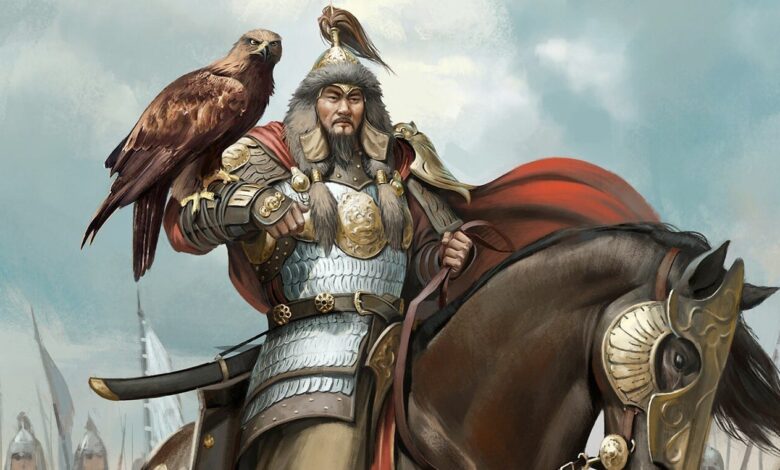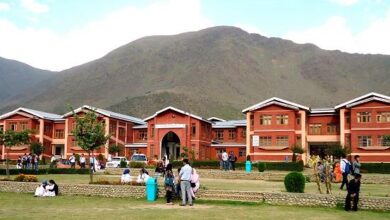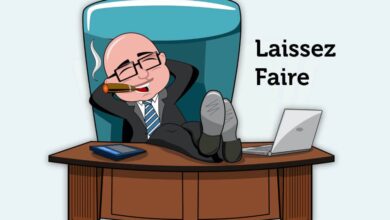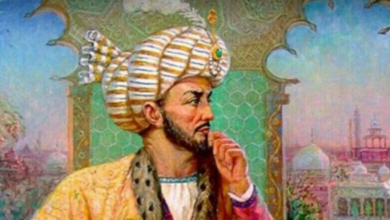Chengiz Khan – ‘The Scrouge of God’

Who were Mongols who suddenly burst forth and astounded the world? The Scythians and the Huns and Turks and the Tartars —all from Central Asia—had already played a notable part in history. Some of these peoples were still prominent; the Seljuq Turks in western Asia, the Tartars in northern China and elsewhere. But the Mongols had so far done nothing much. Probably no one in western Asia knew much about them. They belonged to many unimportant tribes in Mongolia and were subject to the Kin Tartars, who had conquered the north of China.
Suddenly they seemed to gain power. Their scattered tribes joined together and elected a single leader, the Great Khan, and swore allegiance and obedience to him. Under him they marched to Peking and put an end to the Kin Empire. They marched west and swept away the great kingdoms they found on then- way. They went to Russia and subdued it. Later they wiped off completely Baghdad and its empire and went right up to Poland and Central Europe. There was none to stop them. India escaped by a sheer chance. One can well imagine what the amazement of the Eurasian world must have been at this volcanic eruption. It almost seemed like a great natural calamity, like an earthquake, before which man can do little.
Strong men and women they were, these nomads from Mongolia, used to hardship, and living in tents on the wide steppes of northern Asia. But their strength and hard training might not have availed them much if they had not produced a chief who was a most remarkable man. This was the person who is known as Chengiz Khan (or Genghiz or Jenghiz or Jengiz Khan—there are many ways of spelling it). He was born in 1155 A.C. and his original name was Timuchin. His father, Yesugei-Bagatur, died when he was a little boy. ” Bagatur “, by the way, was a favourite name for Mongol nobles. It means ” hero ” and I suppose the Urdu bahadur comes from it.
Although just a little boy of ten, with no one to, help him, he struggled on and on, and ultimately made good. Step by step he advanced till at last the great Mongol Assembly, called the Kurul-tai, met and elected him the Great Khan or Kagan or Emperor. A few years before he had been given the name of Chengiz.
A Secret History of the Mongol People written in the thirteenth century, and published in China in the fourteenth century, describes this election: ” And so, when all the generations living in felt tents became united under a single authority, in the year of the Leopard, they assembled near the sources of the Onon, and raising the White Banner on Nine Legs, they conferred on Chengiz the title of Kagan.”
Chengiz was already fifty-one years of age when he became the Great Khan or Kagan. He was not very young, and most people at this age want peace and quiet. But this was only the beginning of his career of conquest. This is worthy of notice, as most great conquerors do their conquering when fairly young. This also reminds us that Chengiz did not simply dash across Asia in a fit of youthful enthusiasm. He was a cautious and careful middle-aged man, and every big thing he did was preceded by thought and preparation.
The Mongols were nomads, hating cities and the ways of cities. Many people think that because they were nomads they must have been barbarians. But this is a mistaken idea. They did not know, of course, many of the city arts, but they had developed a way of life of their own and had an intricate organization. If they won great victories on the field of battle, it was not because of their numbers, but because of their discipline and organization. And above all it was due to the brilliant captainship of Chengiz. For Chengiz is, without doubt, the greatest military genius and leader in history. Alexander and Caesar seem petty before him. Chengiz was not only himself a very great commander, but he trained many of his generals and made them brilliant leaders. Thousands of miles away from their homelands, surrounded by enemies and a hostile population, they carried on victorious warfare against superior numbers.
What was the map of Asia and Europe like when Chengiz appeared striding over it ? China to the east and south of Mongolia was split up. To the south was the Sung Empire, where the Southern Sungs held sway; to the north, with Peking for their capital, was the empire of the Kin or Golden Tartars, who had driven out the Sungs; to the west, over the Gobi desert and beyond, was the Hsia or Tangut Empire, also nomadic. In India we have seen that the Slave Kings ruled in Delhi. In Persia and Mesopotamia, right up to the frontiers of India, there was the great Muslim kingdom of Khwarazm or Khiva, with its capital at Samarqand. West of this were the Seljuqs, and in Egypt and Palestine the successors of Saladin. Bound Baghdad, the Caliph ruled under the protection of the Seljuqs.
This was the period of the later Crusades. Frederick II of Hohenstaufen, the stupor mundi, was the Emperor of the Holy Roman Empire. In England it was the period of Magna Charta and after. In France, King Louis IX reigned, who went to the Crusades, got captured by the Turks and was then ransomed. In eastern Europe, there was Russia, apparently divided into two States, that of Novgorod in the north and Kiev in the south. Between Russia and the Holy Roman Empire were Hungary and Poland. The Byzantine Empire still flourished round Constantinople.
Chengiz prepared carefully for his conquests. He trained his army and, above all, he trained his horses and remounts, for to a nomad people nothing is more important than horses. He then marched east and almost put an end to the Kin Empire of northern China and Manchuria, and took Peking. He subdued Korea. He appears to have been on good terms with the Southern Sungs who even helped him against the Kins, not realizing that their turn might come next. Chengiz also conquered the Tanguts later.
After these victories Chengiz might have rested. He seems to have had no desire to invade the west. He wanted friendly relations with the Shah or King of Khwarazm. But this was not to be. There is an old Latin saying which means that those whom the gods wish to destroy they first drive mad. The Shah of Khwarazm was bent on bringing about his own destruction and he did everything possible to accomplish this. Mongol merchants were massacred by a governor of his. Chengiz even then wanted peace and sent ambassadors asking that the governor be punished. But the foolish Shah, vain and full of his own importance, insulted these ambassadors and had them put to death. This was more than Chengiz could stand; but he was not to be hurried. He made careful preparations and then marched with his host westward.
This march, begun in 1219, opened the eyes of Asia, and partly of Europe too, to this new terror, this great roller which came on inexorably, crushing down cities and men by the million. The Empire of Khwarazm ceased to exist. The great city of Bokhara, full of palaces, and with over a million population, was reduced to ashes. Samarqand, the capital, was destroyed, and out of a million people that lived there, only 50,000 remained alive. Herat, Balkh and many other flourishing cities were all destroyed. Millions were killed. All the arts and crafts that had flourished in Central Asia for hundreds of years disappeared, civilized life seemed to cease hi Persia and in central Asia. There was desert where Chengiz had passed.
The son of the Shah of Khwarazm, Jalaluddin, fought bravely against this flood. He retreated right up to the Indus river and, pressed hard there, he is said to have jumped on horseback 30 feet down into the great river and swum across. He found shelter at the Delhi Court. Chengiz did not think it worth while to pursue him there.
Fortunately for the Seljuq Turks and Baghdad, Chengiz left them in peace and marched north into Russia. He defeated and took prisoner the Grand Duke of Kiev. He returned east to crush a rebellion of Hsias or Tanguts.
Chengiz died in 1227 at the age of seventy-two. His empire extended from the Black Sea in the west to the Pacific Ocean, and it was still vigorous and growing. His capital was still the little town of Karakorum in Mongolia. Nomad as he was, he was an extremely able organizer, and he was wise enough to employ able ministers to help him. His empire, so rapidly conquered, did not break up at his death.
To Persian and Arab historians Chengiz is a monster —the ” Scourge of God ” as he is called. He is painted as a very cruel person. He was very cruel, no doubt, but he was not very different from many of the rulers of his day. In India the Afghan kings were much the same, on a smaller scale. When Ghazni was captured by the Afghans in 1150 they revenged themselves for an old blood- feud by sacking and burning the city. For seven days ” plunder, devastation -and slaughter were continuous. Every man that was found was slain, and all the women and children were made prisoners. All the palaces and edifices of the Mahmudi Kings (that is, descendants of Sultan Mahmud), which had no equals in the world, were destroyed.” This was the behaviour of Muslims towards brother-Muslims. There was nothing to choose in quality between this and what took place in India under the Afghan kings and Chengiz’s career of destruction in Central Asia and Persia. Chengiz was particularly angry with Khwarazm because his ambassador had been killed by the Shah. For him it was a kind of blood-feud. Elsewhere there was great destruction done by Chengis. But perhaps it was not so great as in Central Asia.
There was another motive behind Chengiz’s destruction of towns. He had the spirit of a nomad, and he hated towns and cities. He liked living in the steppes or great plains. At one time Chengiz considered the desirability of destroying all the cities in China, but fortunately he desisted ! His idea was to combine civilization with a nomadic life. But this was not, and is not, possible.
You might perhaps think from Chengiz Khan’s name that he was a Mohammedan. But this was not so. The name is a Mongol name. Chengiz was a very tolerant person in religion. His religion, such as it was, was Shamaism, a worship of the ” Everlasting Blue Sky “. He used to have long talks with Chinese Tao-ist sages, but he stuck to Shamaism, and when in difficulty, consulted the sky.
You must have noticed, earlier in this letter, that Chengiz was ” elected ” Great Khan by an assembly of the Mongols. This assembly was really a feudal assembly, not a popular one, and Chengiz was thus the feudal head of the clan. He was illiterate, and so also were all his followers. Probably he did not even know that there was such a thing as writing for a long time. Messages were sent by word of mouth, and were usually in verse in the form of allegories and proverbs. It is amazing how business could be carried on in a vast empire by means of oral messages. When Chengiz learnt that there was such a thing as writing, he felt immediately that this was very useful and valuable, and he ordered his sons and chief officers to learn it. He also ordered that the old customary law of the Mongols must be put down in writing, also his own sayings. The idea was that this customary law was the ” unchangeable law ” for ever and ever, and no one could disobey it. Even the Emperor was subject to it. But this ” unchangeable law ” is lost now, and even the present-day Mongols have no recollection or tradition of it.
[Excerpts from Glimpses of World History from JL Nehur]









